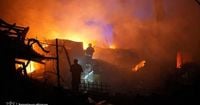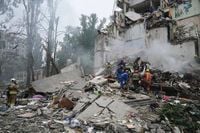In the early hours before September 17, 2025, the southern Ukrainian city of Zaporizhzhia was rocked by a brutal Russian rocket barrage, a chilling reminder that the war in Ukraine—now stretching beyond three and a half years—shows no signs of abating. The attack, which struck more than 20 apartment buildings and set off fires throughout the city, left at least one person dead and dozens wounded, including four children, according to regional governor Ivan Fedorov. For residents who were still recovering from previous bombardments, the devastation was both physically and emotionally exhausting. “We hadn’t yet recovered from enemy strikes on Aug. 30. We are currently repairing those buildings, those windows, but now the enemy has added more work for our municipal workers,” Fedorov told state television, as reported by the Associated Press.
The relentless assault on Zaporizhzhia is just one episode in a wider pattern of Russian attacks across Ukraine. Over the past two weeks alone, Ukrainian President Volodymyr Zelenskyy reported that Russia had launched more than 3,500 drones, over 2,500 powerful glide bombs, and nearly 200 missiles at targets inside Ukraine. These figures, shared by Zelenskyy on Telegram and cited by multiple outlets including AP and BBC, underscore the scale and intensity of the ongoing conflict. The violence has not been limited to Zaporizhzhia: in Kharkiv, Ukraine’s second-largest city, a Russian drone struck the National Pharmaceutical University in the city center, injuring four people, according to local officials and video evidence released by the Kharkiv Regional Prosecutor’s Office.
President Zelenskyy, responding to these attacks, issued an urgent appeal to European leaders. He called for the creation of a multilayered air defense system to jointly protect European skies, arguing that the technologies required are already available. “Now is the time to implement the joint protection of our European skies with a multilayered air defence system. All the technologies for this are available,” Zelenskyy said on Telegram. He continued, “We need investments and desire, we need strong actions and decisions from all our partners.” His message is clear: Ukraine cannot stand alone against the scale and sophistication of Russian aerial assaults, and the security of the entire continent may depend on a collective response.
The war’s front line, stretching roughly 1,000 kilometers, remains highly active, with Russian forces advancing and striking civilian regions without respite. Despite months of US-led peace talks and repeated ultimatums from President Donald Trump for Russian President Vladimir Putin to present proposals to halt the fighting, a settlement remains elusive. As AP and Reuters have reported, the deadlines and demands have come and gone with no tangible progress, leaving Ukrainian cities vulnerable to continued bombardment.
Russian tactics have evolved, posing new challenges for Ukrainian defenses. Glide bombs, typically dropped by jets at high altitude and far behind the front line, have proven particularly devastating. While not highly accurate, these munitions create massive craters and widespread destruction. Ukrainian officials openly admit that they have no effective countermeasures against glide bombs, a vulnerability that Russia seems eager to exploit. Drone swarms compound the threat, overwhelming air defense systems and inflicting both physical and psychological damage on the population.
The impact of Russian strikes has not been confined to Ukrainian territory. In recent weeks, Russian drones have landed on Polish soil, raising alarm within NATO and prompting the alliance to reinforce its European air defenses. According to BBC and AP, these incidents have heightened tensions between Moscow and the West, underscoring the broader security implications of the conflict. NATO’s response has been swift, with additional resources and attention devoted to shoring up the alliance’s eastern flank.
For President Zelenskyy, the stakes are clear. He has repeatedly called for more stringent economic sanctions on Russia, arguing that only severe economic pain will force Moscow to the negotiating table. “The only reason Russia can allow all this is that it doesn’t feel any pain,” Zelenskyy wrote on social media. “Until Russia experiences truly severe losses — above all economic ones — it will avoid genuine diplomacy and an end to the war.” His call for tougher penalties is echoed by Ukrainian officials and many of the country’s Western allies, though debates over the scope and enforcement of sanctions continue to simmer in European capitals.
Ukraine is not simply on the defensive. In response to the unrelenting assaults, Ukrainian forces have developed and deployed their own long-range drones, targeting Russian infrastructure deep behind enemy lines. Recent Ukrainian strikes have hit oil refineries, depots, and ports in western Russia, according to Ukraine’s General Staff. One notable attack targeted an oil refinery in the Saratov region, resulting in explosions and a fire at the facility. These operations, reported by AP and Reuters, have contributed to gasoline shortages within Russia, which remains the world’s second-largest oil exporter. The shortages have been exacerbated by seasonal demand and the cumulative effect of sustained Ukrainian drone strikes.
Despite these counterattacks, the humanitarian toll inside Ukraine remains staggering. Footage from Zaporizhzhia and Kharkiv shows residents surveying shattered homes, burnt vehicles, and the scars of yet another night spent in fear. Municipal workers labor to repair windows and restore basic services, even as new barrages threaten to undo their efforts. The psychological burden is immense, with civilians forced to adapt to a reality where the next attack may come at any moment.
The international community faces a daunting challenge. While NATO’s bolstering of air defenses in response to incursions on Polish territory sends a message of solidarity, the need for a unified European air defense system, as advocated by Zelenskyy, remains pressing. The technologies exist, but political will and coordinated investment are needed to turn the vision into reality. As the war grinds on, the urgency of Zelenskyy’s plea grows ever more apparent.
With peace talks stalled and the front lines unchanged, both Ukraine and its allies confront difficult decisions about the future of the conflict. The question that hangs over Europe is not just how to protect Ukraine, but how to ensure the security of the continent itself in the face of evolving threats. For now, the people of Zaporizhzhia, Kharkiv, and countless other Ukrainian cities endure nightly reminders of the war’s cost, hoping that their calls for help will finally be heard.

